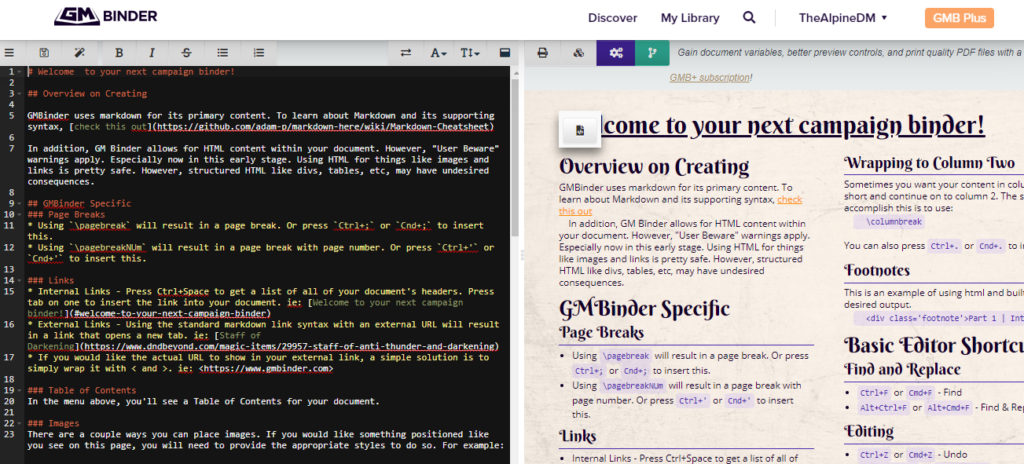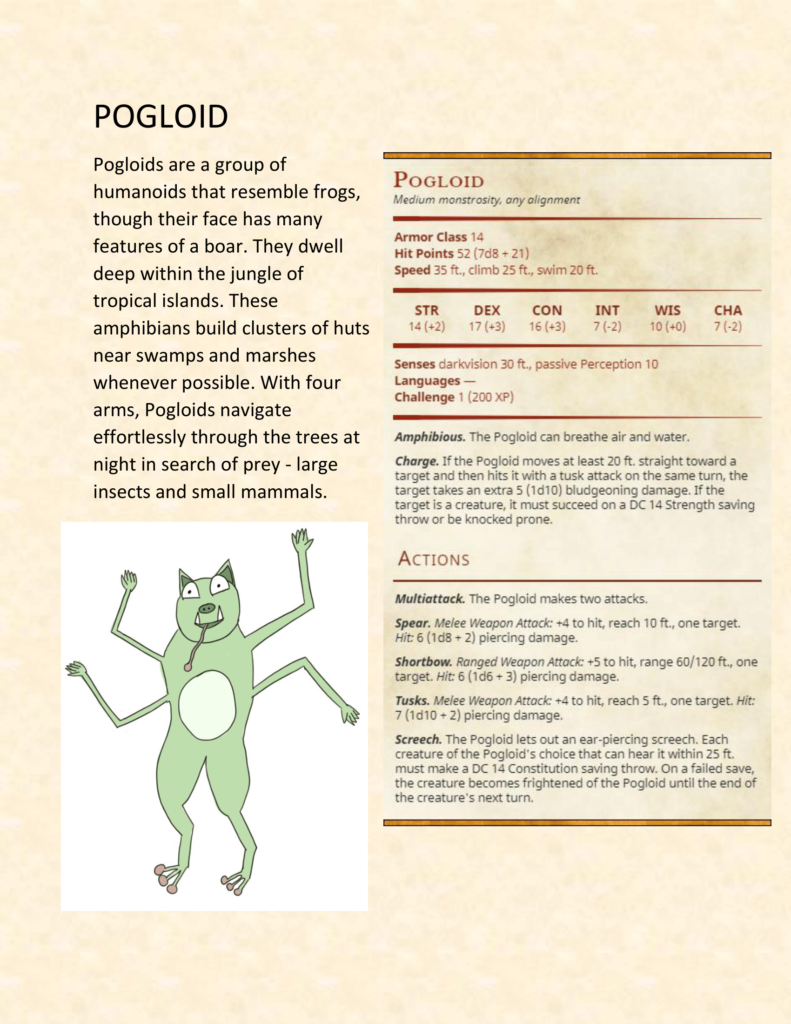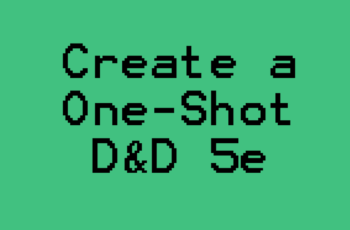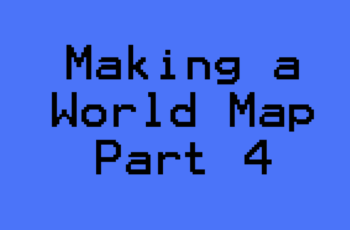Get ready to get creative as we go through the 5 steps for making DnD Homebrew monsters! This might not be the best way, but it sort of outlines my thought process as I’m going about making the monster. Not gonna lie, Step 3 is kind of a doozy but if you stick it out it’ll be worth it. Probably.
Today’s Article Will Discuss:
- Step 1: The Concept
- Step 2: The Tools
- Step 3: The Numbers
- Step 4: The Image
- Step 5: The Lore
Step 1: The Concept
If you’re trying to make a DnD homebrew monster, you probably already have a concept in mind (I mean, you’re reading this article after all…). If so, great! Now you gotta solidify it and turn it from mystic thought-ether into something with a bit more form. This is the most important step so you want to be sure that you’re not rushing through it. The more well-defined and concrete your concept is from the beginning, the easier it will be down the road as you move on to actually making it. If you’re working with a wishy washy abstract idea, you really have no idea what you’re trying to create which is gonna make things harder. Document! Write things down! Solidify them!
You don’t have to write a damn novel, just lay out a couple of key features of your new homebrew monster that will make it stand out and be completely awesome.
For example, I’m gonna be trying to create a Pogloid (pretty sure that’s a made up word). Here’s what I might write down for the concept
- Pogloid = Half pig / Half frog demon
- Has more arms than it really ought to
- Uses these arms (and feet!) to climb on walls and ceilings
- Makes a horrible screech sound
Don’t have any idea what sort of homebrew monster you’d like to make? I’ve got a few tips for you: sit down, slow down, and shut the fuck up. Take 5 minutes to brainstorm.
Here’s a few easy tricks and ideas that I used when coming up with DnD homebrew monster concepts for Ekemon’s Exotic Mounts
- Use an existing animal/monster and add an element!
- (It’s not just a fox, it’s a froststorm fox)
- Add two animals together
- (this is what I’m doing with the Pogloid)
- Wordplay and misnomers are your best friend!
- (A water buffalo, but like an elemental made of water that resembles a buffalo)
- Give something wings
Step 2: The Tools
There are n+1 ways to go about actually “making” the homebrew monster, with some of these methods a bit more complicated than others. This section is here to provide you information to help you get started. But I can’t stress enough the importance of actually getting started, while having the overall ‘finish’ of the homebrew monster come later.
It’s much better get practice making 5 homebrew monsters and only use a pencil than to spend the same amount of time making 1 homebrew monster with 60% of your effort focused on flashiness. As a DM, it’s far more beneficial to understand the monster creation and balancing process than it is to understand the nuances of Photoshop or GM Binder.
But anyway, here’s a few tools you can select from
- GM Binder
- RPG Workshop
- Microsoft Word (or equivalent)
- Photoshop (or equivalent)
- Pen and Paper
GM Binder
An extremely popular method is to use a site called GMBinder. It’s sort of a one-stop-shop while the other methods might require combining a few tools to create a complete homebrew monster. I’ve seen some really neat, professional looking things be created from here but I haven’t actually used it myself so I can’t directly attest to its user-friendliness or steepness of the learning curve. It may look like an intimidating mess of code (it’s markdown, btw), but there are lots of resources if you’re willing to spend a short amount of time learning.

RPG Workshop
If you’ll be using some of the methods below, RPG Workshop is a great tool for making DnD homebrew monster statblocks. It’s as easy as typing the values and abilities you want into the appropriate fields. The tool takes care of the rest for you, allowing you to easily create professional looking statblocks while still focusing on the mechanical and flavorful content. The biggest downside is that – as far as I know – you can’t add things that don’t have a field. For example, if you wanted to create a homebrew monster with a climbing or burrowing speed, you’d be SOL with this tool.
Along the same vein is a site called Tetra-Cube, which I’ve talked about before. It’s essentially the same as RPG Workshop, but with a few more options. You may have to click a couple extra buttons here and there, but it’s still pretty straightforward and simple.
Photoshop (or equivalent)
Photoshop, or any other image editing software, can have a bit of a learning curve if you’re unfamiliar. However, once you get down the basics, it can be a very powerful tool to have in your arsenal as a DM. Aside from making homebrew monsters, you can also use PS for creating player handouts, maps, or even taking a swing at doing some artwork.
For a free alternative, check out GIMP
Microsoft Word (or equivalent)
Who says you need any dang Photoshop?! You can still create a really nice looking homebrew monster with any ole text editor. Use RPG Workshop or Tetra-Cube to generate the statblock, stick it in Word, find yourself a fitting image, and type up a couple of sentences. BOOM, done. Simple as syrup.
With the Pogloid example, I’ll be using microsoft word to demonstrate that even tools like this can be used to create high quality, kinda-polished looking homebrew DnD monsters.
Pen and Paper
You don’t even need to use a computer to make your homebrew monsters (though you may want a digital copy)! There’s nothing wrong with just getting out a piece of paper and going to town. This may be a bit more time consuming than the other methods, and a bit harder to keep organized and clean looking, but as long as you’re having fun and making some content, that’s all that matters!
Step 3: The Numbers
Well, with the general concept nailed down and your tools chosen, it’s time to sit down and actually do the fucking work. Many people may be intimidated by having to come up with the numbers (and maybe even, god forbid, a few words as well), either because they have no idea where to start or because they feel unqualified.
Let’s address these concerns real quick like.
1) It absolutely doesn’t matter where you start. If you want to begin with some of the cool abilities and then focus on ability scores, go for it! I prefer to just start at the top of the statblock and sort of work my way down one item at a time. As the saying goes, whatever tickles your boat.
2) You are almost certainly not qualified if you stumbled here by googling “How to make a DnD homebrew monster”. That’s totally okay. The only way to get better is through purposeful practice, and also I’m absolutely not qualified to make homebrew monsters either. But I enjoy the creative process so I’m trying to slowly get better and better (KAIZEN, BITCHES!).
I’m just going to start walking through the process for Pogloids!
Name
Hopefully you have something picked out from Step 1, but if not there’s also all sorts of name generators available out there. I came up with Pogloid by playing around with the words Pig + Frog + Humanoid.
Size
How big do you want your homebrew monster to be? A quick reminder that Tiny and Medium creatures take up a standard 5ft x 5ft square. Each size above Medium expands the perimeter by an additional 5 ft (Large = 10×10, Huge = 15×15, etc).
Pogloids are Medium sized
Type
There’s a bunch of different monster types in DnD. (Check out my article here that briefly covers them!). At face value, the monster type won’t change anything. However, there are various spells and abilities that may affect different monster types in different ways. Just choose the one that feels the most fitting!
Pogloids are Monstrosities
Alignment
I don’t assign any alignments to homebrew monsters I create, and I don’t pay any attention to the alignment of official monsters. Have your monsters act however you want them to, there’s no need to paint yourself into a corner.
Armor Class
Is your homebrew monster pretty squishy or are they virtually untouchable? Consider the creature that you are making and think about any defenses that it might have. Does it wear any armor? Does it have any natural protection, such as a thick hide or natural carapace? If so, consider bumping the AC up by a couple of points.
Something else to keep in mind is the Size of the creature. Kind of like piñatas, larger monsters tend to be easier to hit while smaller ones are more difficult to hit.
For Armor Class (and honestly a lot more of the traits that you’re about to assign) I’ve found it really helpful to study a wide range of statblocks for existing creatures. For example, a Black Pudding has an AC of 7 (big and slow), Wolf has an AC of 13 (a little smaller and faster), while an Adult Red Dragon has an AC of 19 (big, but tough scales)
For Pogloids I’m going to go with a base AC of 14, but I’d also like to make a Pogloid variant (Berserker) with an AC of 16.
Hit Points
In addition to its Armor Class, your homebrew monster’s hit points are a large contributor to ‘how tough a monster is’. For this step, you can just come up with a number but I think it’s better to assign it some hit dice. This automatically provides a range of possible hit points, instead of only having a static number.
Just like different Character Classes have different sized hit die, monsters have different sized hit die depending on their size. Typically Medium creatures have a d8, Large have a d10, and Huge have a d12. You can also completely ignore the typical conventions and give creatures whatever sized hit die you damn well please. I promise I won’t tell.
Again, it may be helpful to study a few creatures that are similar in size, strength, or ability to the one that you are trying to create.
Keep in mind that your homebrew monster will – in addition to the HP from hit dice – also get additional hit points based on their Constitution score (and modifier). So for now, instead of determining a FINAL value for hit points, I’ll only be deciding on how many hit die they have. Once we get around to assigning their ability scores, specifically constitution, then we will circle back around and calculate a final value for hit points.
For Pogloids, I’m thinking that I’d like them to have hitpoints somewhere between 40 and 60. As a medium creature, they’ll be using a d8 for their hit die. I played around with some values on Tetra-Cube until I decided that 7 was a good amount of dice. I don’t have much of a formula for this, unfortunately, it’s a bit more of a guess-and-check sort of situation.
Speed
Is your homebrew a lumbering giant, or a quick and nimble spider-monkey? Consider the different character concepts that you brainstormed in Step 1. Thematically, would any of these traits make them faster or grant them an alternative type of movement? I like to start my homebrew creatures with a base speed of 30 ft, and then modify it as I see fit.
Some of the different Speed types are
- climbing
- swimming
- burrow
- fly
For Pogloids, I’m imagining them as moving through the jungle pretty quickly since their legs are long and lanky, and they have extra limbs. Additionally, one of the defining characteristics is that they use their froggy-like feet to scale trees and swim, so I’ll also be giving them a climbing speed and a small swim speed. I’ll grant them an additional speed of 5 ft from the “baseline”, bringing their Speed to 35 ft. I’ll set their climbing speed to 25 ft and swimming speed to 20 ft. They can still pretty quick, but not as fast as they can go normally.
Ability Scores
In Dungeons and Dragons, every monster (and character) has a score for each of the different abilities
- Strength
- Dexterity
- Constitution
- Wisdom
- Intelligence
- Charisma
When assigning your scores, a good benchmark to keep in mind is that the average person you might pass walking down the street has about a 10 for their ability scores. Right smack dab in the middle.
Take some time to think about the homebrew monster you’re creating. Like with everything else, the numbers can be pretty much whatever you want them to be, but instead of just shooting in the dark, you can mentally compare the creature that you’re trying to create.
Do you think your homebrew monster is as strong as a Black Bear and as smart as a Beholder? Compare, adjust, repeat until satisfied.
For the Pogloid
- Strength = 14
- Dexterity = 17
- Constitution = 16
- Wisdom = 10
- Intelligence = 7
- Charisma = 7
Now that we’ve assigned our Constitution score, we can revisit HP and calculate the final value.
To do this, you’ll need to figure out the modifiers for each score. This can be found in the character creation section of the PHB, or you can look at the chart below. The chart below will also be used when determining bonuses for attacking and whatnot.
Ability Score Modifier Table
| 1 | −5 |
| 2–3 | −4 |
| 4–5 | −3 |
| 6–7 | −2 |
| 8–9 | −1 |
| 10–11 | +0 |
| 12–13 | +1 |
| 14–15 | +2 |
| 16–17 | +3 |
| 18–19 | +4 |
| 20–21 | +5 |
With a Con score of 16, that gives the Podloids a Modifier of +. I gave them 7 hit die (of a d8) which averages out to 31 (rounded down). We then add the modifier for each hit dice, so 31 + (7*3) = 52 average hit points
Various Traits
The next section to work through has a lot of different areas involved, though many are completely optional. For these I won’t go into too much detail, but here are a couple of things you may want to consider adding to your homebrew monster
- Saving Throw bonuses
- Skill bonuses
- Vulnerabilities/Resistances/Immunities
Senses
If your homebrew monster can sense creatures in the dark (darkvision) or has alternative methods of sensing (such as tremorsense, blindsense, or truesight) be sure to include it here
Even if your creature doesn’t have special senses, you’ll need to include their passive perception score. This will be equal to 10 + their Wisdom modifier.
Pogloids are active at night, so I’ll be giving them darkvision out to a distance of 30 feet. Aside from this, they have no additional senses. Their passive perception is 10 (10 + 0).
Languages
The language section is pretty straightforward, just ask yourself whether your homebrew creature speaks any languages. Even if it’s only Common, be sure to include it
Pogloids speak Common (yes I forgot it on the final statblock, my bad)
Challenge
A creature’s Challenge Rating will roughly tell you how difficult of an opponent they will be in combat. You can adjust this value on TetraCube near the bottom. I don’t pay too much attention to it honestly, but if you want to learn more or try checking out this CR Calculator Tool
Abilities
Here’s where you can reeaaallly start getting creative if you want to, but it’s also where you can really fuck up how balanced your creature is. Giving it some crazy abilities will be super cool, but try to keep the player’s perspective in mind. You may want enemies to be powerful and frightening, but I never want my players to feel completely overwhelmed and absolutely hopeless.
Once again, my best advice is to study the statblocks of existing creatures – especially ones that are similar to the homebrew monster that you’re creating. If you’re unsure about creating your own abilities from scratch, consider taking some existing abilities and modifying them.
Think back to some of the core concepts that you defined waay back in Step 1. Now is probably the time to flesh those concepts out a bit and bring them to life, mechanically speaking. Don’t be afraid to include cool little abilities for outside of combat situations, you never know what use may come of them.
Pogloids
Since being half-frog is one of the main features of Pogloids, I’ll be giving them the ability to breathe both air and water (Amphibious)
Coming from the pig side of things, I want the Pogloids to have large tusks. From studying other creatures (hint hint), I know about an ability called Charge. This ability will give the Pogloid’s tusk attack additional bonuses if the Pogloid moves towards their target before attacking.
For now, I think these two abilities should suffice. You can always add more, but try not to get too crazy.
Actions
Another fun step is coming up with different attacks and Actions that your homebrew monster will get to use. Many monsters are able to attack more than once per round with an ‘ability’ called Multiattack – I’m giving Pogloids this ability since they’ve got extra limbs
For basic attacks, ask yourself whether your homebrew monster would be a melee fighter, a ranged fighter, or – if you’re feeling spicy – both. Just like with characters, a monster’s attack and damage bonuses comes from their relevant ability modifier (typically strength for melee and dexterity for ranged). They may also have an additional modifier for their attacks based on CR.
- Multiattack
- Spear +4, 1d8+2 piercing
- Shortbow +5, 1d6+3 piercing
- Tusks +4, 1d10+2 piercing
Your homebrew monster may have some other cool Actions it can take based on some of its core concepts. I tend to think of an idea that would be cool, and then find an ability or spell that causes a similar effect. You don’t have to copy the effect exactly, but this gives you a good starting place and will help get you familiarized with some Action mechanics other than just attacking.
Pogloids are half pig, and one thing that I think of when I think of pigs is a scrieching oinking noise. I’m imagining this as a sort of war call strikes fear into the enemies. An ability that comes to mind is the Fey Precense of an Archfey Warlock. I’m changing it a bit to be based on hearing the screech instead of just being within 10 feet, and making it only cause the frightneed condition
There are also legendary and lair actions, but that’s a whole thing and we’re not getting into that today.
Step 4: The Image
With all the crunchy technical stuff out of the way, the rest of creating a homebrew monster is just smooth, creative sailing – and also completely optional. If you’re satisfied with just having a statblock, then congrats! You did the dang thing.
On the other hand, if you really want to blow everyone’s nips off with your big brain then you’re gonna want to add an image and a little bit of lore.
There are three main ways I can think of to get an image
- Draw it yourself
- Hire Someone
- Find an Image
Draw it Yourself
The sky’s the limit here, folks! If you’re an artist, great. If not, then just do your best. I’m certainly not an artist but I’m going to be taking a stab at drawing Pogloids. It won’t be pretty, but at least I can try to encourage others to give it a shot.
Hire Someone
If you’ve got some extra cash laying around and want to use it to fuel your creative creations, you can hire somebody to do an art commission of your monster. There are lots of ways to find artists, but Fiverr and Reddit are a good place to start
Find an Image
You don’t have to pay money to get a high quality image for your homebrew monster. The biggest downside to this is that you have no input. Sometimes you get lucky and find a image that really closely represents the monster you’re creating, and other times there won’t really be anything close.
Disclaimer: if you’re using your monster for anything other than personal use at a home game, you’ll want to be extra careful with attribution and licensing. Give awesome artists the credit (and/or money) they deserve!
For some royalty free stuff, I’ve used Pixabay but you’ll probably have some trouble finding a representative image
Step 5: The Lore
The final step in creating a homebrew monster is building it into your world and giving it some context. This is your final opportunity to present any last little tid-bits of information about your monster or explain some of its cool abilities in-game.
You can write a few sentences or multiple pages, whatever you’re feeling. Think of this step as a creative writing assignment where your prompt is anything and everything related to your homebrew monster. I’ll just go ahead and list a few questions to get you thinking:
- Where does your creature live?
- What does it eat?
- Does it have a social structure?
- Is your creature significant to anyone?
- Is there a historical event linked to the creature?
- What is the creature’s general temperament?
- Does it have any predators?
- What does it do – if anything – for fun?
- Why is this creature significant?
Here’s a few quick sentences I can put together by answering some of these questions
Pogloids are a group of humanoids that resemble frogs, though their face has many features of a boar. They dwell deep within the jungle of tropical islands. These amphibians build clusters of huts near swamps and marshes whenever possible. With four arms, Pogloids navigate effortlessly through the trees at night in search of prey – large insects and small mammals.
Nothing crazy, right? But even just those four sentences give you a much better idea of a Pogloid’s place in the world compared to only a statblock and a picture.
Finally we throw it all together in microsoft word, slap a papyrus-lookin’ background on there and voila! A homebrew monster for DnD that doesn’t look half bad if I say so muh’self. If you spend a bit more time polishing up your homebrew monster you can get some awesome results! But remember that it’s about the process, not the end result. Anyway, that’s how I go about making homebrew monsters for DnD. I hope you found this helpful!


FREE 5 day email course
Be sure to join the email list and sign up for the FREE 5-day email course centered on running your very own homebrew campaign! You'll learn everything you need to get started, from designing a story arc to reacting to (unexpected) player choices.
What to do When You Can’t Play DnD
Campaign on a temporary hiatus, but still want to play...
Read MoreHow to Easily Design a One-Shot for D&D 5e
If you're crunched on time, or just want to switch...
Read MoreHow to Make a D&D World Map: A Non-Artist’s Guide (Part 4)
In the final post of the map making series, I'll...
Read More


